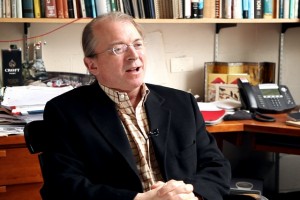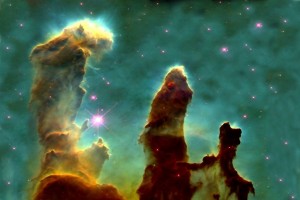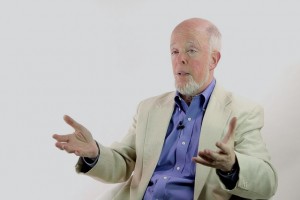Quantum Communication and Heat Transfer
Physicist Seth Lloyd on development of quantum mechanics, nanoscale interactions, and overcoming energy crisis
Why do bankers and politicians turn to quantum physicists to protect their most valuable information? Why if we measure one particle, this will affect another particle distantly connected to the first one? Why did the CIA support non-traditional research? These and other questions are answered by Germeshausen Professor of the History of Science David Kaiser.
One of the areas that’s of an enormous interest and excitement today across physics and engineering goes by new name called ‘quantum information science’ – QIS. And that involves theoretical physicists, experimental physicists, mathematicians, engineers of many stripes. And it’s leading to amazing breakthroughs in a laboratory – things like quantum encryption, early progress in quantum computers. There were even real world demonstrations of quantum encryption, where people have used this new technique to protect the transfer of information, like money wires, between the bank and the city hall, or the circulation of electronic voting in federal elections. And so this is an amazing new development that rests on some fundamental insights into the nature of quantum mechanics. That is about to be poised to be sort of multibillion dollar worldwide industry.
So I’ve been curious how do we get to a world in which bankers and politicians turn to quantum physicists to protect their most valuable information. That seems like a weird and a new kind of development. The origin of this field comes, certainly, in part, from a kind of from not as exciting a time in physics, in fact, from a kind of years of a kind of hardship in the field, from the early mid-nineteen seventies, when physics was in the doldrums by many ways of trying to characterize it. There had been an enormous growth in the field after WWII in the United States, in the Soviet Union throughout Western Europe. And they had come crashing, tumbling down around 1970. So much of it in the United States by the early 1970s, by 1972, there are more than a thousand young PHD’s in physics looking for jobs and only 50 jobs to compete for. So a thousand to fifty and at just the bottom has fallen out. It was a horrible time to be young physicist in the United States.
An so it turns out in the midst of that kind of enormous dislocation there was a group of very smart, very well-trained young physicists. They got they PhD’s sort of at just the wrong moment. They were trained in some of the most elite programs across the United States, they had their PHD’s, they published good journal articles. And they were looking for jobs just as the market was the most horrible.
When so many people were going without jobs in the field for which they trained so hard. So these folks, there were about ten of them all together, trought different kinds of quirky actions of history they wound up bumbling along and they made their way to Berkeley California – right near San Francisco. Most of them were either out of work or kind of underemployed, they were not getting the kinds of jobs they had anticipated with their fancy PhD’s. But they also realized they shared among each other a passion, a real driving interest in the foundations of modern physics, in the kind of the philosophical basis for this emerging and very counterintuitive view of the world. And they had time in their hands. So they met together and they formed an informal, very playful discussion group. They called themselves ‘the fundamental physics group’, they were just being playful. They met at Berkeley every Friday afternoon for about four years week after week after week, and they decided if they might not be able to pursue a typical career in physics, they could at least try to go after their deep curiosity about the world.
One of the topics really dominated their discussion, and that’s called ‘quantum entanglement’, often called Bell’s theorem, named after an Irish physicist named John Bell. Bell had been fascinated also by the kind of deep questions at the heart of quantum mechanics, which were not garnering a lot of attention in his day, this was a kind of a side interest of his in he kept kind of quiet. And he published a paper, a quite remarkable, elegant paper, in the mid 1960s which showed that if our current understanding of quantum theory is correct – that was an “if” – if our current understanding of quantum theory is correct then the world should be subject to this kind of very strange property, very strange behavior, where quantum particles, objects that had once interacted could retain a kind of connection with each other even if they were moved arbitrarily far apart.
In fact, one founding member of the group, John Clauser, had even performed the very first laboratory test of this strange idea. He and his student, Stuart Friedman, had actually conducted a laboratory test to see are the predictions of quantum mechanics really borne out. Does it matter if I make a measurement of this particle here, does it affect the type of outcomes that are measured here instantaneously, that is, faster than could travel between.
So they were obsessed with this and enamored with this question of quantum entanglement. It turns out that while they were doing all this work in the San-Francisco area in 1970’s, when San-Francisco was going through an enormous kind of counterculture bloom, when all kinds of nerdy-sounding ideas were more in the mainstream there than in most other places. So the regular newspapers would routinely report on experiments in mindreading, in ESP, and things like spoon bending, and occult stuff, and UFOs, and staff that brings a smile to our faces till this day, it should.
And so we had this group of people who are digging in to learn more and more about this preposterous sounding feature of quantum mechanics, this attachment as if what I do here can somehow affect what happens here instantly. And some of them began to wonder is that really so different than mind-reading or ESP, or even further – might there be an actual explanation for some of these strange-sounding phenomena? This was the time when mind-reading experiments were, in fact, as I say, certainly not believed by everyone, but they had a kind of local presence in the newspapers, in discussion groups and all that in San-Francisco at that time, all out of proportions ever before and since.
So these folks began to wonder about quantum entanglement and its possible even weirder implications. Well, I mentioned, these folks by and large do not have so regular jobs, few of them were in universities, they weren’t getting large grants from the National Science Foundation – the way most physicists might support their work, and so what they were able to do is couple together – akind of unusual support network. So one source of the funding for only some of these folks turned out to be the Central Intelligence Agency, the CIA. It turns out some analysts, and basically some spies in the US government were worried at just that the time that the Soviet Union was getting much better at mind-reading than the US. We’ve seen examples of intelligence going awry time and time again. And at that time there were earnest classified briefings: the Soviets are advanced in mind reading, maybe advanced in mind control – that’s of course sets all kinds of warning bells in the US government. And so that starts opening up funding for what we might call non-traditional research in areas like mind reading. S
o there was as we now know years and years later, some of these reports were declassified, millions and millions, tens of millions of dollars were spent by the federal government on mind-reading experiments. And some of these sort of underemployed Berkley physicists were hired as consultants, they would help work on some of these, try to explain some of these phenomena using what they know about some of these weird quirky features of quantum mechanics. Another source of support were sort of California entrepreneurs of this kind of New Age hippie counterculture spirit, people who worked on things like the Human Potential movement. Could these wacky new ideas about quantum theory, about how the particles could share an attachment across time and space, could that help unlock human potential? Are humans capable of so much more than our conventional understandings would allow? So some of then became enamored of this new work, very generous sponsors, they too devoted money year after year to try to support this kind of strange or unusual group of very smart and very quirky young physicists in California. They helped spread their words through unusual means; they didn’t submit most of their works to the main journals like the Physical Review. The Physical Review had a kind of barrier, or at least a very high rejection rate on anything on the foundations of quantum mechanics, like Bell’s theorem, let alone force of like ESP. So they were not publishing in the main physics journals, though they had before, they were certainly well-trained. But instead a lot of their works circulated in kind of underground hippie networks, they were mimeographed and sent by post, through the mail to this kind of mishmash of people that included Nobel laureates in Physics most of whom hadn’t asked for these materials, they would show up in their mailbox, to occult enthusiasts, to military, to, you know, spooks, and everything in between.
So they were getting their word out in a kind of curios way, and someone who also helped get the word out through writing very-very successful popular books. They were successful because they sold millions of copies, and they were also successful some of them won big book awards. These were considered well-written books in their day. Books like The Tao of Physics by Fritjof Capra,The Dancing Wu Li Masters by Gary Zukav – these were widely, widely bestselling popular books. They were written by members of this group or friends of the group and trying to get into print this cluster of new ideas about the real spookiness of quantum mechanics and maybe some of its further along implications.
And so what really fascinated me was really when we start digging into how we get to a field like quantum information science today we realize that these folks had cornered the market in thinking hard about Bell’s theorem at the time when very few physicists were. They really were thinking hard about quantum entanglement when it was still out of fashion. And even more important they produced a series of thought experiments, increasingly clever, very ingenious thought experiments, because they really thought that Bell’s theorem would be in conflict with Einstein’s relativity. And that has big stakes – they thought, and they had a good reason to think so, even John Bell wondered whether this ‘spooky action at a distance’ – tickle a particle here and it changes something over here instantaneously – that seems to violate relativity and causality at least as physicists understood it. It looked like the two pillars in modern physics were heading for collision. Would quantum theory actually be compatible with relativity? If not that would be big news. So members of this Berkeley group, this fundamental physics group began designing very clever thought experiments to force the issue to try to find that weak joint in the architecture of modern physics. And through this sort of underground network, through this sort of mimeograph things that show up in various people’s mailboxes they spread the word and, in fact, they helped instigate a number of other physicists to try to think about that very carefully – the stakes were very high. And so by responding to some of these thought experiments from this Berkeley group a number of other physicists around the world – some in Europe, some in various places in North America wound up proving new features about quantum mechanics that no one had known or done before. Heisenberg hadn’t done before, John Bell himself hadn’t done before, the most famous of which today is called the ‘no-cloning theorem’ – a deep fundamental fact about quantum theory that no one had known, and it was discovered precisely by trying to unpack these clever provocations from this Berkeley group. Well, turns out quantum entanglement and this follow-up called the no-cloning theorem. Those are the most important starting ingredients for things like quantum encryption, that’s how we get encrypted quantum systems today.
Further along, members of this group were writing kind of the earliest pedagogical materials to get news about quantum entanglement into the physics classrooms, because the textbooks hadn’t caught up yet. So you take this whole package together and it looks like this group in Berkeley, they were wrong more often than they were right, all scientists are, we all make mistakes all the time. But often their mistakes were very productive mistakes. These were extremely well-trained and disciplined folks, they’ve done all the problem sets, who also were out of the ordinary routine. They were asking sort of free-willing or unusual questions and that combination lead to some very creative and very unusual brain-storming from which eventually the entire community could learn and benefit.
So what we have at the end of the day in this kind of crazy collision of different kinds people and personalities and ideas is a bunch of mostly out of work hippies or some people who were deeply into this San-Francisco hippie counterculture scene, who also had been very well-trained, they’ve done all their problem sets, they were well-disciplined, they were open to a whole range of ideas, some of them frankly quite nerdy-sounding. So they combined sort of training and a kind of way-out-there perspective that was quite different from the mainstream. And together they were able to produce a string of what we might call productive mistakes: they were wrong, they were wrong more often than they were right, like all scientists, but some of the times when they were wrong they were wrong in very productive ways and that bequeathed the entire community a set of things that we all now know that none of us knew before.

Physicist Seth Lloyd on development of quantum mechanics, nanoscale interactions, and overcoming energy crisis

The dense cores of star-forming clouds have been observed for the first time in a tiny dwarf galaxy.

Astrophysicist Christopher McKee on the birth of stars, ways to determine the mass of a primordial star, and t...